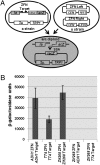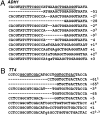High frequency targeted mutagenesis in Arabidopsis thaliana using zinc finger nucleases
- PMID: 20508152
- PMCID: PMC2900673
- DOI: 10.1073/pnas.0914991107
High frequency targeted mutagenesis in Arabidopsis thaliana using zinc finger nucleases
Abstract
We report here an efficient method for targeted mutagenesis of Arabidopsis genes through regulated expression of zinc finger nucleases (ZFNs)-enzymes engineered to create DNA double-strand breaks at specific target loci. ZFNs recognizing the Arabidopsis ADH1 and TT4 genes were made by Oligomerized Pool ENgineering (OPEN)-a publicly available, selection-based platform that yields high quality zinc finger arrays. The ADH1 and TT4 ZFNs were placed under control of an estrogen-inducible promoter and introduced into Arabidopsis plants by floral-dip transformation. Primary transgenic Arabidopsis seedlings induced to express the ADH1 or TT4 ZFNs exhibited somatic mutation frequencies of 7% or 16%, respectively. The induced mutations were typically insertions or deletions (1-142 bp) that were localized at the ZFN cleavage site and likely derived from imprecise repair of chromosome breaks by nonhomologous end-joining. Mutations were transmitted to the next generation for 69% of primary transgenics expressing the ADH1 ZFNs and 33% of transgenics expressing the TT4 ZFNs. Furthermore, approximately 20% of the mutant-producing plants were homozygous for mutations at ADH1 or TT4, indicating that both alleles were disrupted. ADH1 and TT4 were chosen as targets for this study because of their selectable or screenable phenotypes (adh1, allyl alcohol resistance; tt4, lack of anthocyanins in the seed coat). However, the high frequency of observed ZFN-induced mutagenesis suggests that targeted mutations can readily be recovered by simply screening progeny of primary transgenic plants by PCR and DNA sequencing. Taken together, our results suggest that it should now be possible to obtain mutations in any Arabidopsis target gene regardless of its mutant phenotype.
Conflict of interest statement
The authors declare no conflict of interest.
Figures




Comment in
-
Breaking news: plants mutate right on target.Proc Natl Acad Sci U S A. 2010 Jun 29;107(26):11657-8. doi: 10.1073/pnas.1006364107. Epub 2010 Jun 16. Proc Natl Acad Sci U S A. 2010. PMID: 20554917 Free PMC article. No abstract available.
Similar articles
-
Increasing frequencies of site-specific mutagenesis and gene targeting in Arabidopsis by manipulating DNA repair pathways.Genome Res. 2013 Mar;23(3):547-54. doi: 10.1101/gr.145557.112. Epub 2013 Jan 2. Genome Res. 2013. PMID: 23282329 Free PMC article.
-
Site-directed mutagenesis in Arabidopsis using custom-designed zinc finger nucleases.Proc Natl Acad Sci U S A. 2010 Jun 29;107(26):12034-9. doi: 10.1073/pnas.1000234107. Epub 2010 May 27. Proc Natl Acad Sci U S A. 2010. PMID: 20508151 Free PMC article.
-
Targeted mutagenesis in Arabidopsis using zinc-finger nucleases.Methods Mol Biol. 2011;701:167-77. doi: 10.1007/978-1-61737-957-4_9. Methods Mol Biol. 2011. PMID: 21181530
-
Gene targeting in plants: 25 years later.Int J Dev Biol. 2013;57(6-8):629-37. doi: 10.1387/ijdb.130194hp. Int J Dev Biol. 2013. PMID: 24166445 Review.
-
Custom-designed zinc finger nucleases: what is next?Cell Mol Life Sci. 2007 Nov;64(22):2933-44. doi: 10.1007/s00018-007-7206-8. Cell Mol Life Sci. 2007. PMID: 17763826 Free PMC article. Review.
Cited by
-
Less is more: strategies to remove marker genes from transgenic plants.BMC Biotechnol. 2013 Apr 23;13:36. doi: 10.1186/1472-6750-13-36. BMC Biotechnol. 2013. PMID: 23617583 Free PMC article. Review.
-
Genome-Wide Assessment of Efficiency and Specificity in CRISPR/Cas9 Mediated Multiple Site Targeting in Arabidopsis.PLoS One. 2016 Sep 13;11(9):e0162169. doi: 10.1371/journal.pone.0162169. eCollection 2016. PLoS One. 2016. PMID: 27622539 Free PMC article.
-
In planta gene targeting.Proc Natl Acad Sci U S A. 2012 May 8;109(19):7535-40. doi: 10.1073/pnas.1202191109. Epub 2012 Apr 23. Proc Natl Acad Sci U S A. 2012. PMID: 22529367 Free PMC article.
-
TAL effector nucleases induce mutations at a pre-selected location in the genome of primary barley transformants.Plant Mol Biol. 2013 Oct;83(3):279-85. doi: 10.1007/s11103-013-0078-4. Epub 2013 May 21. Plant Mol Biol. 2013. PMID: 23689819 Free PMC article.
-
Powdery mildew resistance in tomato by impairment of SlPMR4 and SlDMR1.PLoS One. 2013 Jun 20;8(6):e67467. doi: 10.1371/journal.pone.0067467. Print 2013. PLoS One. 2013. PMID: 23818978 Free PMC article.
References
-
- Doetschman T, et al. Targetted correction of a mutant HPRT gene in mouse embryonic stem cells. Nature. 1987;330:576–578. - PubMed
-
- Rothstein RJ. One-step gene disruption in yeast. Methods Enzymol. 1983;101:202–211. - PubMed
-
- Thomas KR, Capecchi MR. Site-directed mutagenesis by gene targeting in mouse embryo-derived stem cells. Cell. 1987;51:503–512. - PubMed
-
- Cathomen T, Joung JK. Zinc-finger nucleases: The next generation emerges. Mol Ther. 2008;16:1200–1207. - PubMed
-
- Wyman C, Kanaar R. DNA double-strand break repair: All's well that ends well. Annu Rev Genet. 2006;40:363–383. - PubMed
Publication types
MeSH terms
Substances
Grants and funding
LinkOut - more resources
Full Text Sources
Other Literature Sources
Molecular Biology Databases
Research Materials

